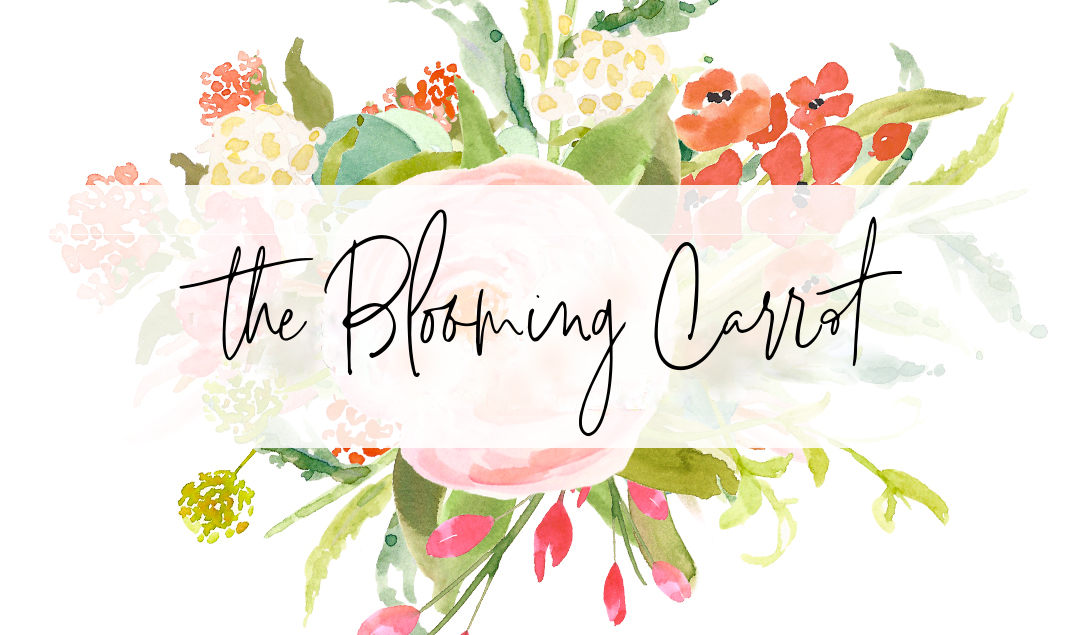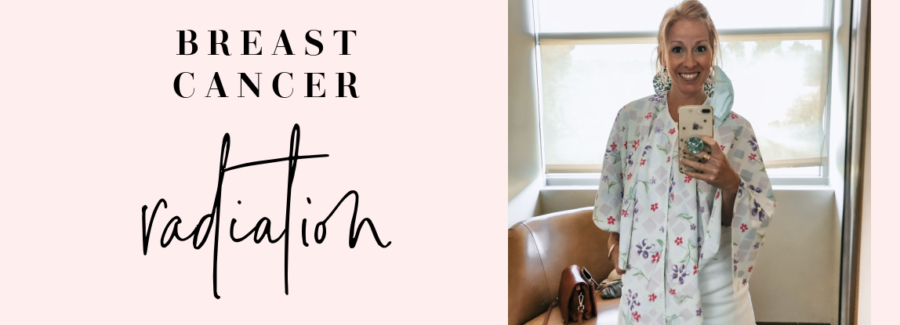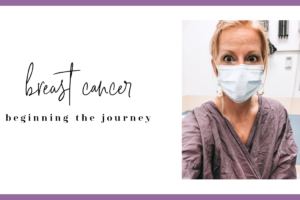It seems like such a long time since my breast cancer diagnosis, but it’s really only been 3 months. We FINALLY got my onco-type dx score back on the tumor following my lumpectomy and it was GREAT NEWS! A low score (10), which is what we were hoping for. One of my doctors explained that the onco-type testing basically tells them if the cancer cells have legs to be able to move through my body. A low score means low risk. And importantly…NO CHEMO REC from the docs!! That confirms that radiation is the next step. Along with estrogen blocking hormone therapy, but that’s another post.
From the beginning, I’ve had some fear around radiation. I have a hard time with the idea of harming my body with the intention of healing. Radiation works by killing off ALL the cells in the area that is radiated. Cancer cells can’t repair themselves and they die off. Healthy cells CAN repair and start healing themselves and replicating. The idea is to kill off any rogue cancer cells that are too small to be detected yet. However, there are some potentially scary and long-term risks with radiation, including DNA damage and increased risk of other types of cancer. I initially wasn’t sure if I would do the radiation, since I’m doing several alternative therapies and have made important lifestyle changes. (If you haven’t, check out Anticancer Living by Lorenzo Cohen, director of Integrative Medicine at MD Anderson!) After talking with multiple specialists, including various medical oncologists, my long-time integrative medicine doc and my naturopathic oncologist, every one of them agreed that I would likely benefit from radiation given my specific situation. So, here we go.
This post contains affiliate links for products I’ve used and love.
Let’s Do It
Like the rest of this cancer journey, if I’m doing it, I’m doing it with a positive attitude. I’m focused on the good it is doing in my body and not all the potential scariness. And keeping my body strong and healthy for healing. My radiation oncologist worked with a physicist to determine exactly where and how much. My personalized plan is 16 regular treatments, followed by 4 “booster” treatments. The boosters are because of my age (I’m 43 which is still relatively young in the breast cancer world) and are specific just to the area the tumor was removed instead of the entire breast. Every weekday until I’m done, 5 days on and weekends off.
Every morning at 8:45am, I show up for my treatment. When they’re ready for me, I head back to change out of my shirt into this super cute cape. At this point, let’s be honest, modesty is out the door. I literally don’t even care any more. LOL!

The same two ladies handle my treatments each time. They are two shiny rays of sunshine! Happy, kind, energetic. They truly make every day easier. If you’ve never seen a radiation machine (I know, most people haven’t!), this is what it looks like. Before treatments started, they fitted me for a customized mat that molds to my body. It keeps it’s shape and each treatment, I lay down on the machine on my personal cushion. It helps make sure I stay in the same position each time. They also had me choose a Pandora station. Each day I walk in to Zac Brown radio playing. We listen to that same station on our patio and by the pool almost daily, so it gives me the happy, relaxed feels. They also give me a warm blanket each time. It gets a little chilly with your shirt open for the whole treatment! HAHA!
The actual radiation is less than a minute. I’m probably laying on the machine for 5 minutes. All in all, each day is pretty quick in and out.
What To Expect
The most common issues that go along with radiation treatments are skin irritation and fatigue. The skin basically gets burned by the treatments. It can be minor, redness and irritation. It was also be significant burns and cause open blisters. Even better, some of the skin issues can be permanent, such as discoloration and leathery skin. Fun times. I’m using a few things to support my skin to stay moisturized and heal.
- Young Living Lavaderm Cooling Mist – I start with this one and spray it on about an hour after radiation and again before bed (and sometimes randomly throughout the day). I have ALWAYS loved this spray for after-sun and the ingredients are fabulous. It includes aloe and three essential oils that are super nourishing to skin.
- Pure aloe – Right now I’m using pure aloe directly from plants a sweet friend gifted me. I also purchased some from Natural Grocers as a back-up (THIS one). I’m applying it liberally after the Lavaderm spray morning and night.
- dermavitality Radiation Relief Cream – My doctor’s office recommended Aquaphor. While some people feel the ingredients aren’t terrible, but I don’t love them. (The active ingredient, petrolatum, is classified as a carcinogen by the European Union.) I don’t feel comfortable smearing something on my boobs during cancer treatment that I wouldn’t normally buy and use. In fact, I feel just the opposite right now! It’s important to me that everything my boobs are absorbing is safe and organic. That’s why I decided on this cream instead. So far, I love the ingredients and the consistency of the cream. You can find it HERE.
Fatigue happens because the body is working harder on healing damaged cells. The longer radiation goes on, the more likely and significant the fatigue can be. The most important thing I’m doing right now is being gentle with myself. I’m a goer and a doer. There’s a lot that a cancer journey takes away from you. Living normal life helps me feel more in control, but the reality is now isn’t the time to overachieve. I’m keeping my schedule more open, doing less than I typically do, and mentally being intentional about giving myself love and grace right now. And making sure to get plenty of sleep and feed myself healthy, nourishing foods.
I will come back and update this post with how I’m doing with both of these as radiation progresses.
Here’s a tip I wish someone had told me. You get all kinds of special “tattoos” for radiation. Mine are drawn with black marker and then covered with waterproof stickers so I can swim and shower. The technicians use the markers, along with light lasers from the radiation room, to make sure my body is in the exact right, same position each time. The marks get touched up with more marker every few treatments. But guess what? Lots of the black marker ISN’T covered by stickers and comes off on my bras. So a tip I wish I’d known…wear an old bra! Don’t wear anything new or cute, because it ends up stained with marker. I don’t usually like to show this much skin on the internet, but here are what mine look like (not pictured…LOTS more on both boobs!). I’m rocking a Sally vibe from Nightmare Before Christmas under my bra.

Supporting My Body to Heal
If I’m being honest, I’m still not sure this is the right next step. I’m trusting that God’s got this. My job is to lay fear at His feet and let Him do His thing, whatever that may be. I’m choosing His peace over fear during radiation. I’m also doing some alternative therapies and taking some specialized supplements that may help make any cancer cells more susceptible to radiation and help protect and heal healthy cells. Again, these are all personalized to me and done under the supervision of my healthcare team.
- Mistletoe Therapy: This is part of my natural treatment plan and may help with radiation too. It’s done through injections that I give myself at home. Considering I’m not a needle person AT ALL (I almost pass out giving blood, lol!), I’m pretty proud of this new skill! Mistletoe is one of the most widely studied complimentary and alternative therapies for cancer. It’s one of the most commonly prescribed treatments for patients in Europe, Germany, and Switzerland. It may help boost the immune system and alleviate some of the symptoms from radiation. You can learn more HERE.
- Bioavailable Turmeric & Melatonin Supplements: Curcumin, the compound found primarily in turmeric, is well-known for being anti-inflammatory. And most cancer patients have inflammation, although it’s not widely understood exactly why (chicken or the egg?). Growing research research suggests that curcumin may help prevent cancer, slow the spread of cancer, make chemotherapy more effective and protect healthy cells from damage by radiation therapy. Melatonin is most well known for sleep benefits, but also linked to immune function, cell signaling and hormone balance. More HERE on both. I’m also taking a good Vitamin C and Vitamin D supplement daily.
- Sleep: Sleep is where healing truly takes place. It reduces stress, regenerates cells, balances hormones, SO many good things. I typically always make good sleep a priority, but even more so right now. I have lots of sleep tips HERE.
- Food: I’m looking at this as an opportunity to feed my body and cells foods that will nourish, protect healthy cells and help with the healing process. I’m focused on mostly fruits and vegetables, healthy nuts, and some limited healthy fish and meat. Little to no dairy and sugar. My goal is to flood my body with as many naturally occurring whole food nutrients as possible. And also balance. While I don’t think it serves a cancer patient to be told to not worry about diet and just eat what makes you happy during treatment (where do nutrients for healing and energy come from then???), I am committed to balance and being gentle with myself. For example, a few nights ago our kids ended up with my mom for the afternoon and dinner. Scott and I had what we call “adult swim” (floating in the pool with NO kids!) for 30 minutes and then went to MOD Pizza, just the two of us. Dairy and sausage aren’t on my list of nourishing foods, but there’s a mental and emotional benefit to quality time, date night and normalcy with my husband. So…balance.
Most of all, I’m being more gentle with myself than I’ve ever been. I’m prioritizing myself and not feeling guilty about it. I’m getting extra hugs from Scott and the kids. This too shall pass, but right now, I’m okay with giving my mind and body what I need to stay positive, connected and healthy.
XO, Kelli
NOTE: This is my personal journey. My treatments (traditional and naturopathic) are being overseen by medical professionals. This is not intended to be advice. Please find professionals you trust to work in partnership with you.









